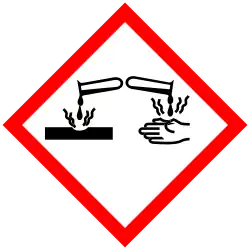Samarium(III) hydroxide
_hydroxide.jpg) | |
| Identifiers | |
|---|---|
3D model (JSmol)
|
|
| ChemSpider | |
| ECHA InfoCard | 100.039.791 |
| EC Number |
|
PubChem CID
|
|
CompTox Dashboard (EPA)
|
|
| |
| |
| Properties | |
| Sm(OH)3 | |
| Molar mass | 201.386 |
| Appearance | yellow solid[1] |
| Hazards | |
| GHS labelling: | |

| |
| Danger | |
| H314 | |
| P260, P264, P280, P301+P330+P331, P303+P361+P353, P304+P340, P305+P351+P338, P310, P321, P363, P405, P501 | |
| Related compounds | |
Other anions
|
samarium oxide |
Other cations
|
neodymium(III) hydroxide europium(III) hydroxide |
Except where otherwise noted, data are given for materials in their standard state (at 25 °C [77 °F], 100 kPa).
Infobox references
| |
Samarium(III) hydroxide is an inorganic compound with chemical formula Sm(OH)3.
Chemical properties
Samarium(III) hydroxide can react with acid and produce samarium salts:
- Sm(OH)3 + 3 H+ → Sm3+ + 3 H2O
Samarium(III) hydroxide will decompose to SmO(OH) when heated; continued heating produces Sm2O3.[1]